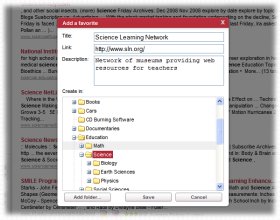|
Education
Web
Viewing 1-3 of 3 total results
evidence is required to evaluate hypotheses and explanations; c) comparing different scientific explanations for a set of observations about the Earth; d) explaining that observation and logic are essential for reaching a conclusion; and e) evaluating evidence for scientific the...
1
0
evidence is required to evaluate hypotheses and explanations; c) comparing different scientific explanations for a set of observations about the Earth; d) explaining that observation and logic are essential for reaching a conclusion; and e) evaluating evidence for scientific theories. ES.3 The student will investigate and understand how to read and interpret maps, globes, models, charts, and imagery. Key concepts include a) maps (bathymetric, geologic, topographic, and weather) and star charts; b) imagery
31
0
http://www.doe.virginia.gov/VDOE/Superintendent/Sols/sciencesol.pdf#page=31
www.doe.virginia.gov/VDOE/Superintendent/Sols/sciencesol.pdf#page=31
evidence is required to evaluate hypotheses and explanations; c) comparing different scientific explanations <span class="highlight">for</span> a set of observations about the Earth; d) explaining that observation and logic are essential <span class="highlight">for</span> reaching a conclusion; and e) evaluating evidence <span class="highlight">for</span> scientific theories. ES.3 The student will investigate and understand how to read and interpret <span class="highlight">maps</span>, globes, models, charts, and imagery. Key concepts include a) <span class="highlight">maps</span> (bathymetric, geologic, <span class="highlight">topographic</span>, and weather) and star charts; b) imagery
examine the role of water on the Earth. • Surface Examples: waves, glaciers, rivers • Underground Example: aquifers • Atmosphere Examples: precipitation, humidity (Comprehension) 6.E.1.3. Students are able to explain processes involved in the formation of the Earth’s structure....
1
0
examine the role of water on the Earth. • Surface Examples: waves, glaciers, rivers • Underground Example: aquifers • Atmosphere Examples: precipitation, humidity (Comprehension) 6.E.1.3. Students are able to explain processes involved in the formation of the Earth’s structure. Examples: plate tectonics, volcanoes, earthquakes #0;9 Interpret topographic and digital imagery or remotely sensed data to identify surface features. Examples: local, global, regional #0;9 Explain the formation of
99
0
http://doe.sd.gov/contentstandards/science/docs/2005/EarthSpace/South%20Dakota%20Science%202005.pdf#page=99
doe.sd.gov/contentstandards/science/docs/2005/EarthSpace/South%20Dakota%2...
examine the role of water on the Earth. • Surface Examples: waves, glaciers, rivers • Underground Example: aquifers • Atmosphere Examples: precipitation, humidity (Comprehension) 6.E.1.3. Students are able to explain processes involved in the formation of the Earth’s structure. Examples: plate tectonics, volcanoes, earthquakes #0;9 Interpret <span class="highlight">topographic</span> and <span class="highlight">digital</span> imagery or remotely sensed data to identify surface features. Examples: local, global, regional #0;9 Explain the formation of
Microsoft Word - ssstd7.docssstd7.pdf
the data on-line and add information to the base map. Analyze the maps created to note any spatial patterns in farm concentrations, changes over the last few decades, and hypothesize possible reasons. Overlay the maps with additional GIS data showing precipitation, land topogr...
1
0
the data on-line and add information to the base map. Analyze the maps created to note any spatial patterns in farm concentrations, changes over the last few decades, and hypothesize possible reasons. Overlay the maps with additional GIS data showing precipitation, land topography, and any other factors that students include in the hypothesis. Write conclusions resulting from the analysis. Sources for GIS data include the Kansas Data Access and Support Center, in conjunction with the Kansas
1
0
http://www.ksde.org/LinkClick.aspx?fileticket=giNc9khF9Cs%3d&tabid=1715&mid=8016&forcedownload=true#page=11
www.ksde.org/LinkClick.aspx?fileticket=giNc9khF9Cs%3d&tabid=1715&mid=8016...
the data on-<span class="highlight">line</span> and add information to the base map. Analyze the <span class="highlight">maps</span> created to note any spatial patterns in farm concentrations, changes over the last few decades, and hypothesize possible reasons. Overlay the <span class="highlight">maps</span> with additional GIS data showing precipitation, land topography, and any other factors that students include in the hypothesis. Write conclusions resulting from the analysis. Sources <span class="highlight">for</span> GIS data include the Kansas Data Access and Support Center, in conjunction with the Kansas
|
